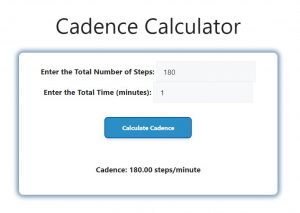About Cadence Calculator (Formula)
Cadence, whether in cycling or running, refers to the number of revolutions per minute (RPM) for cyclists or steps per minute (SPM) for runners. It’s an important measure of performance, efficiency, and form. A good cadence can help athletes optimize their energy usage and improve overall speed. This guide will walk you through the formula, how to use the Cadence Calculator, an example, and common questions.
Formula
The formula for calculating cadence is:
Cadence (C) = Strides or Revolutions (S) / Time (T)
Where:
- C = Cadence (steps per minute for runners or revolutions per minute for cyclists)
- S = Strides or revolutions taken
- T = Time in minutes
How to Use
- Measure Strides or Revolutions (S): For runners, count your steps; for cyclists, count the number of pedal revolutions.
- Determine the Time (T): Measure the time in minutes over which you’ve counted the strides or revolutions.
- Apply the Formula: Divide the total strides or revolutions by the time to get your cadence.
- Use the Calculator: Enter the total strides/revolutions and the time into the Cadence Calculator for an instant result.
Example
Let’s say a runner takes 180 steps over a span of 1 minute. Using the formula:
C = 180 / 1
C = 180 steps per minute
For this runner, the cadence is 180 steps per minute.

FAQs
- What is cadence?
Cadence refers to the number of revolutions (cycling) or steps (running) per minute. - Why is cadence important?
Cadence helps athletes optimize their performance, conserve energy, and maintain better form. It’s crucial for increasing speed efficiently. - What is a good cadence for running?
A common target for running cadence is around 180 steps per minute for experienced runners, but it can vary based on fitness level and running style. - What is a good cadence for cycling?
Most cyclists aim for a cadence of 80-100 revolutions per minute, though professional cyclists may aim higher. - How can I improve my cadence?
To improve cadence, gradually increase your step or pedal rate over time while focusing on maintaining good form. - How does cadence affect running efficiency?
A higher cadence can reduce the time your feet spend on the ground, which helps minimize energy loss and lowers the risk of injury. - Can cadence vary between uphill and flat terrains?
Yes, cadence often decreases when going uphill due to increased resistance but can be adjusted to maintain a steady effort. - What tools can I use to measure cadence?
You can use wearable devices like GPS watches, cadence sensors for cycling, or apps that track your steps or pedal revolutions. - Does cadence affect cycling speed?
Yes, higher cadence generally leads to more efficient energy use, which can result in improved cycling speed over time. - How do I calculate cadence without a device?
Count your steps (running) or pedal revolutions (cycling) for a set period (like 1 minute) and divide by the time in minutes. - Is there a perfect cadence for everyone?
No, cadence varies from person to person depending on body type, fitness level, and specific goals. - Does cadence affect heart rate?
Yes, increasing your cadence may raise your heart rate as you exert more effort, though it can also improve cardiovascular efficiency over time. - Can I use the cadence formula for both running and cycling?
Yes, the formula applies to both running and cycling as long as you count steps for running or revolutions for cycling. - Is cadence important for treadmill running?
Yes, maintaining a consistent cadence on the treadmill can help improve form and endurance just like outdoor running. - What’s the difference between stride length and cadence?
Stride length is the distance covered in one step, while cadence measures how many steps you take in a minute. - Can low cadence lead to injury?
Yes, a low cadence can result in overstriding, which places more impact on your joints and can lead to injuries over time. - How can I track my cadence improvement over time?
Use fitness trackers or cadence sensors that store your data so you can compare your cadence over days, weeks, or months. - What’s the relationship between cadence and running speed?
Running speed is a combination of cadence and stride length. By increasing either, you can improve your overall speed. - Can I use this calculator for indoor cycling or spinning?
Yes, the cadence formula applies to indoor cycling as well. Just count the pedal revolutions. - Does cadence training apply to walking too?
Yes, cadence can be used in walking to track steps per minute and improve walking pace and efficiency.
Conclusion
The Cadence Calculator is a useful tool for athletes looking to measure and improve their running or cycling performance. By calculating cadence, you can track your progress, optimize your workouts, and avoid injury. Whether you’re a runner looking to increase your steps per minute or a cyclist aiming for a higher RPM, this calculator can help guide your training and set achievable cadence goals.
Related:
